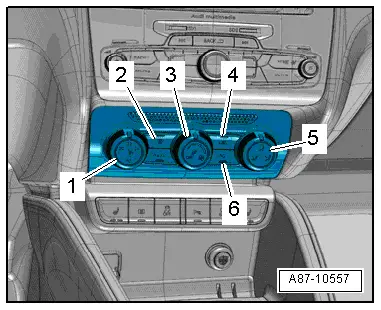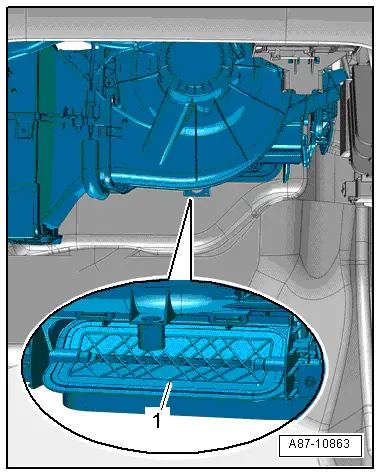| –
| Compare the measured value displayed (for -G263-) to the values in the graph. |
| A - | Air temperature measured by evaporator output temperature sender -G263- |
| C - | Permissible tolerance range |
| Depending on ambient temperature, the measured air temperature must be within the stated tolerance range after 5 minutes. |

Note | t
| If the required values are not attained, check the measured value for the evaporator output temperature sender -G263- and the centre vent temperature sender -G191- and compare the measured values displayed. When doing so, check that there is actually a flow of air to these temperature sensors (observe air distribution). |
| t
| If the measured values in the display zones differ, perform the measures for fault finding to be taken if the readout does not match the specification → Chapter. |
| t
| If the measured value for the evaporator output temperature sender -G263- is greater than the measured value for the centre vent temperature sender -G191-, check for proper installation of -G263- and perform the electrical checks for this sender in the
„Guided fault-finding“ function → Vehicle diagnostic tester. |
| t
| Operation of the air conditioner can be seen, for example, from the fact that the refrigerant pipe on the low-pressure end (thick pipe) cools down. |
| If the measured value of the evaporator output temperature sender -G263- (and thus the system cooling output) is OK: |
| –
| Compare the measured value displayed (for the evaporator output temperature sender -G263-) to the measured value for the centre vent temperature sender -G191-. When doing so, check that there is actually a flow of air to these temperature sensors (observe air distribution). |
| After 5 minutes, the measured value for -G191- must not be more than 3 °C higher than the value for -G263-. |

Note | t
| Depending on the operating unit, Climatronic control unit -J255-, the temperature flap control motor -V68- on vehicles manufactured in 2010 may also be displayed as left temperature flap control motor -V158- → Vehicle diagnostic tester,
„Guided fault-finding“ function. |
| t
| If the measured value for the centre vent temperature sender -G191- is lower thant that for the evaporator output temperature sender -G263-, check for proper installation of -G263- and -G191- as well as checking the electrical connections for contact resistance. Replace the defective sender if necessary. |
| t
| If no fault is found at the centre vent temperature sender -G191- and the temperature flap control motor -V68-, perform the measures to be taken in the event of temperature increase downstream of the evaporator → Chapter. |
| t
| The temperature of the air flow from the
„Centre“ dash panel vents can additionally be measured using a commercially available thermometer for example. |
| t
| Problems relating to differences between the temperature of the air emitted from the vents with an identical setting in air conditioner control mode may be due to the following: The temperature flaps in the air distribution housing not closing completely or reaching their end position → Chapter „Removing and installing air distribution housing“ and
„Guided fault-finding“ function → Vehicle diagnostic tester. Air in the heat exchanger (fluctuating flow through heat exchanger and thus uneven heat distribution) → Chapter or detachment of foam seal on installation of heat exchanger, thus allowing air to flow past the heat exchanger. |
|
|

|
 Note
Note


 Note
Note Note
Note Note
Note

 Note
Note Note
Note
